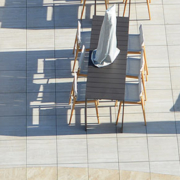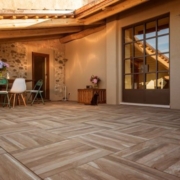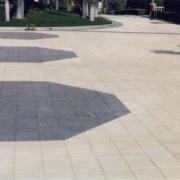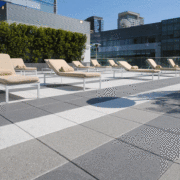The Best Ways To Take Care Of Porcelain Pavers
Porcelain pavers are one of the easiest hardscape materials to maintain. Beloved for being so low maintenance, they’re incredibly durable without requiring annual re-sealing or other extensive cleaning processes. However, care still needs to be taken to ensure that they last as long as possible. If you want to extend the lifespan of your outdoor porcelain pavers and keep them in their best condition, follow these simple tips for cleaning porcelain deck tiles.
Clean Dirt
Dirt and debris are inevitable in an area with foot traffic, so you’ll need to clean your outdoor porcelain pavers occasionally to avoid wear and tear. Dirt can become abrasive to the stone if not cleaned properly, reducing the lifespan of your investment.
To clean your porcelain deck tiles, brush them regularly with a soft bristle broom or brush. Avoid using metal or coarse scrubbers, as these can damage the paver’s surface. Periodically, brush your paving tiles with a mix of water and mild detergent to help remove any dried dirt or spills. Rinse the area with clean water and allow it to dry fully before proceeding with further maintenance, such as re-sealing.
Remove Stains
Porcelain pavers are non-porous, meaning they’re incredibly stain resistant. However, on the off chance that they do become stained, you can follow a few simple steps to eliminate stains and restore the appearance of your outdoor porcelain pavers.
Firstly, try cleaning the area with a mixture of lukewarm water and mild soap. Never use bleach or ammonia, even on the most stubborn stains, as these solutions could irreparably damage your porcelain pavers.
If a soap mixture fails to remove the stain, try an alkaline detergent and rinse thoroughly after cleaning. For rust marks, use a vinegar or lemon juice solution and soak the area for five minutes before attempting to scrub out the stain. No matter what solution you choose, don’t forget to thoroughly rinse the area after you’re finished to remove any residue.
Eliminate Weeds
Weed growth is typically minimal on porcelain pavers that receive regular use, but areas with high humidity or areas that don’t get used often may see weed growth over time. If you notice any unsightly grass or weeds pop up, tear them out from the root and apply a chemical weed deterrent to prevent them from recurring.
Frequent mowing and the application of a mild herbicide are the most effective weed prevention methods for porcelain deck tiles. Adding stone edgers between your porcelain pavers and the rest of your yard can also help create separation and prevent weeds from invading your deck pavers.
Power Wash Your Porcelain Pavers
Power washing is a highly effective way to keep the surface of your porcelain pavers clean and well-maintained. However, always ensure that the power lance isn’t pointed directly at the joints while spraying. Instead, hold the lance at a narrow angle while continually moving it over the pavers’ surface.
Perform Seasonal Porcelain Paver Maintenance
With each season’s unique weather patterns come unique maintenance requirements. During fall, when leaves are falling onto your porcelain deck tiles, it’s important to remove this debris regularly by hand, vacuum, soft-bristle broom, or leaf blower. The longer this organic matter stays on your porcelain pavers, especially when wet, the higher the chances of permanent staining.
During winter, remove snow from your porcelain pavers to avoid the risk of slipping. You can safely apply de-icing products without damaging your deck pavers, so you can ensure a safe and dry environment for your family, guests, or clients.
Porcelain outdoor tiles are some of the most low-maintenance deck pavers on the market. If you want beauty, durability, and a return on investment, Tile Tech porcelain deck tiles are the premier choice for residential and commercial applications of all types. To find out more about porcelain pavers or to receive a free project estimate, give us a call today at (888) 380-5575 or fill out our online contact form. We’d be happy to provide you with a free catalog or product sample and answer any questions you may have.





















